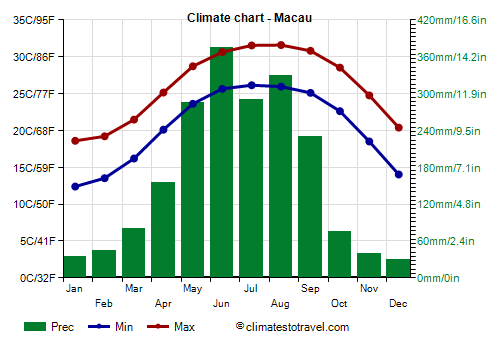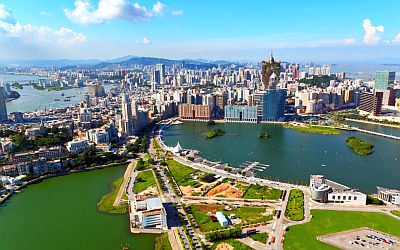Select units of measurement for the temperature and rainfall tables (metric or imperial).
Average weather, temperature, rainfall, sunshine
The climate of Macau is
subtropical, with a very mild, relatively dry winter from December to February, and a hot, muggy and rainy period from May to September.
The city, a special administrative region of China, overlooks the South China Sea, and is located at 22 degrees north latitude, in the metropolitan area of the Pearl River Delta, which includes cities such as Guangzhou (Canton), Shenzhen and Hong Kong.

The climate in detail
The seasons
Winter, from December to February, is very mild, with highs around 19/20 °C (66/68 °F).
The sun shines roughly half the time in December, then it gradually becomes less frequent, and there are more and more days with
cloudy skies, fog and drizzle.
There may also be
windy days.
Some days can be pleasantly warm, in fact, the temperature can reach and exceed 25 °C (77 °F) even in the middle of winter.
In other circumstances, there can be
very cool days, during which the temperature can drop to around 10/15 °C (50/59 °F) during the day, and the wind can increase the feeling of cold.
Occasionally, it can even get
cold, with lows around 5 °C (41 °F) and highs around 10 °C (50 °F). In January 2016, there was a day with a minimum of 2 °C (35.5 °F) and a maximum of 7 °C (44.5 °F).
Spring, from March to May, is very mild or pleasantly warm, but the sky is almost always
cloudy, in addition, there may be
fog in March and April. In March, a cold wind can still blow, with highs around 13/15 °C (55/59 °F), especially in the first half of the month.
Starting from mid-March, with the increase in temperature, the first thunderstorms occur. Already in May, the weather is hot and sultry, with highs around 29 °C (84 °F), even though it's not as hot as in the summer months; moreover, the rains become significant.

The long
summer, from June to September, is hot, humid, and rainy, with heavy showers or thunderstorms, although the sun shines on average for a few hours per day. Daytime temperatures are around 31/32 °C (88/90 °F), and the heat is felt because of moisture coming from the sea. Luckily, there is widespread use of air conditioning; moreover, in the afternoon, the breeze blows from the sea. Usually, the weather remains hot and muggy even at night: lows rarely drop below 25 °C (77 °F), but they can also remain around 28/29 °C (82/84 °F). On sunny days, the temperature can reach 35 °C (95 °F). In recent decades, the record is 37.4 °C (99.3 °F), set in July 2005.
In July, there is often a pause, a period of good weather lasting a week or two.
The probability of typhoons is highest in this season. Typhoons bring heavy rains and strong winds for a few days, with the risk of flooding and storm surges.
In the short
autumn, in October and November, the rains become rare and generally not abundant, and the sun is a bit more frequent than in the other seasons.
In the first part of October, it can still be hot and muggy, but it gradually becomes more pleasant; in this month, however, and sometimes even in the first half of November, tropical cyclones can still arrive. In November, the temperature is generally pleasant, with highs around 25 °C (77 °F), but cool and windy days gradually become more likely, and sometimes, in the second part of the month, it can get a bit cold.
Temperature and rainfall
In Macau, the average temperature ranges from 15.5 °C (60 °F) in January to 28.8 °C (83.8 °F) in July and August.
Rainfall in Macau is abundant, in fact, it is around 2,000 millimeters (81 inches) per year. The rainiest period is from May to August, when the rainfall exceeds 280 mm (11 in) per month, while the least rainy period is from November to February, when it drops below 50 mm (2 in) per month.
Sunshine
Macau gets 1,750 hours of
sunshine per year. So, the amount of sunshine is not great, and it's scarce from February to April, when the sky is often overcast. In the rainy season, the sun shines paradoxically more often, since the rains occur in the form of downpours or thunderstorms, which do not last long, and make room for the sun after a while, except when typhoons hit the area. In autumn, the amount of sunshine remains acceptable or improves slightly, however, cloudy days are possible in this season as well.
Sea temperature
The
sea in Macau is warm enough to swim in from April to November, and becomes definitely warm from May to October. In midwinter, the South China Sea is very cool: it drops to 20 °C (68 °F) in January and February.
Typhoons
As mentioned earlier, Macau can be hit by typhoons, the tropical cyclones of Southeast Asia. Typically, typhoons occur in this area from June to early November, but they have sometimes affected this area outside of this period, as happened in April 2008 with Typhoon Neoguri (or Ambo) and in May 2006 with Typhoon Chanchu (or Caloy).
When to go
It's not easy to find the
best time to visit Macau.
Winter can be a good period, although the sky is often cloudy in the second part; moreover, it can be windy, and sometimes, though rarely, it can be a little cold.
Spring is pleasantly warm, but it's still cloudy, and when the sun becomes a little more frequent, the rains begin as well, then, starting from May, the air becomes muggy and there is some risk (though still low) of typhoons.
In theory, autumn is the best season, but in October, a typhoon can still affect this area, while in November, there can be the first cool and windy days, and sometimes at the end of the month, it can already be a little cold.
All in all, the best times are
from mid-March to mid-April and from mid-October to late November.
What to pack
In
winter: bring spring/autumn clothes, a sweatshirt or sweater, a jacket, a raincoat or umbrella, and a hat for colder days.
In
summer: bring tropics-friendly, lightweight clothing, a light sweatshirt for air-conditioned places, and a light raincoat or umbrella.
Climate data - Macau
| Macau |
|---|
|
| Jan | Feb | Mar | Apr | May | Jun | Jul | Aug | Sep | Oct | Nov | Dec |
|---|
| Min temp. | 13 | 14 | 16 | 20 | 24 | 26 | 26 | 26 | 25 | 23 | 19 | 14 |
|---|
| Max temp. | 19 | 19 | 21 | 25 | 29 | 30 | 31 | 32 | 31 | 28 | 25 | 20 |
|---|
| Precip. | 35 | 45 | 80 | 155 | 285 | 375 | 290 | 330 | 230 | 75 | 40 | 30 |
|---|
| Prec. days | 6 | 9 | 11 | 12 | 14 | 18 | 17 | 16 | 12 | 6 | 5 | 5 |
|---|
|
|
| Sun hours | 4 | 3 | 2 | 3 | 4 | 5 | 7 | 6 | 6 | 6 | 5 | 5 |
|---|
| Sea temp | 20 | 20 | 21 | 23 | 26 | 28 | 29 | 29 | 28 | 27 | 24 | 21 |
|---|